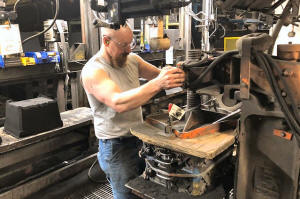|
Why Caterpillar can't keep up with a boom
in demand
 Send a link to a friend
Send a link to a friend
 [May 23, 2018]
By Timothy Aeppel and Rajesh Kumar Singh [May 23, 2018]
By Timothy Aeppel and Rajesh Kumar Singh
EAST PEORIA, Ill. (Reuters) - Orders for
the mining machines and construction bulldozers made at this sprawling
Caterpillar Inc. <CAT.N> factory in central Illinois have jumped, in
general, three-fold over the past year.
But meeting that boom in demand at the world's largest heavy equipment
manufacturer is a challenge, in part because of Caterpillar suppliers
like Steve Kirsh.
Years of watching Caterpillar and other big manufacturers cut
inventories, close plants and axe workers in the last downturn has
embedded caution in Kirsh's ambition to expand after the surge in
orders, reflecting a more fundamental shift in how many industrial
businesses view expansions, according to interviews with Caterpillar
executives, more than a half-dozen Caterpillar suppliers and U.S.
economic data.
"I just wasn't sure it was real," said Kirsh, speaking from a windowless
office at the front of Kirsh Foundry Inc., in Beaver Dam, Wisconsin,
which makes metal parts for Caterpillar and other customers.
Even with a surplus in demand for its product, Caterpillar CEO Jim
Umpleby told investors last month the company will not invest in factory
capacity. Instead, it plans to spend more on new technologies, expanding
its parts business and selling more rental and used equipment.

The company's big East Peoria assembly plant runs just one shift and
operates only four days a week, while its own parts-making facilities
are running three shifts, five days a week to provide it enough
components to assemble, according to the company officials. Outside
suppliers are similarly scrambling to catch up to the surge in orders.
This has extended the lead-time to deliver final products to dealers.
For instance, it takes more than eight months to get one model of its
large engines into a customer's hands.
The Trump administration's efforts to rewrite trade relations with key
partners, especially China, only add to the uncertainty. The latest move
to step back from a confrontation with China is good news for many
domestic producers, who worry that a trade war could quickly puncture
the global expansion, going on nine years, which is feeding the U.S.
factory boom, manufacturing executives told Reuters.
The result is a drag on the economic expansion that President Trump and
Republicans hoped for coming off U.S. corporate tax reform last year.
The idea behind Trump's tax reform was that companies could pour more
money into expansions, hire more workers and lift wages.
There has been an upswing in plans for capital spending, but much of it
is concentrated in the technology and energy sectors. Spending plans by
industrial companies are up only slightly. For a graphic, click
https://tmsnrt.rs/2IBSzKF
For those companies that do want to expand, from car companies to
railroads and engine makers, they often can't find the workers to expand
fast enough.
The contraction of their supply chain in the last downturn thrust many
players big and small into a "just in time delivery" business model,
creating order backlogs, which has led to soaring prices for raw
materials in the recent upswing. For a graphic, click
https://tmsnrt.rs/2rY3iZp
TURNING THE SWITCH BACK ON
The hesitation to expand Caterpillar's supply chain is rooted in the
last bust, notable as the longest downturn in its history - worse than
the Great Depression - from 2012 to 2016, when sales dropped more than
40 percent.
Chastised by that slump, the Deerfield, Ill.-based company embarked on a
restructuring strategy that aims to squeeze more production from its
factories and buy more of what it needs from outside suppliers on a
just-in-time basis.

Caterpillar has closed or restructured more than 25 factories and its
full-time workforce is smaller now than it was at the end of 2012. And
cuts continue. Caterpillar plans to close two more facilities this year
and is considering shuttering an engine plant, which would eliminate 880
jobs.
Caterpillar executives said the new strategy is boosting profitability
by allowing it to get the best use out of its existing factories. They
blame the backlogs on its suppliers' inability to keep up with the surge
in orders.
Timing is part of the problem. Caterpillar and a host of other
industrial companies all ramped up orders at the same time. "That switch
got turned on after being turned off for several years - all at the same
time," said Amy Campbell, director of investor relations.
Campbell, however, said the supply situation is improving. The central
Illinois plant will go back to the normal five-day shift beginning in
June.
Caterpillar's investors love this approach, since it helps deliver
strong margins in the good times and minimizes pain in bad times.
[to top of second column]
|

A worker uses a hydraulic press to squeeze sand into a mold that
will be used to make parts at Kirsh Foundry Inc. in Beaver Dam,
Wisconsin, U.S., April 12, 2018. Picture taken April 12, 2018.
REUTERS/Timothy Aeppel

The company recently boosted profit projections for 2018 by about 25
percent, and in the latest quarter, every segment posted better
results compared to a year ago. But its stock price took a hit when
the company's CFO warned higher prices for raw materials like steel
are going to start squeezing margins even as growth continues.
Supply chain bottlenecks, meanwhile, are hitting companies across
the industrial heartland.
The Institute for Supply Management's index for order backlogs, one
of the best U.S. metrics for how quickly manufacturers are meeting
demand, now stands at its highest level in 14 years. And many
companies remain tight fisted. The Commerce Department recently
reported that orders for capital goods, a key measure of business
investment, fell in March, the third decline in four months. These
numbers show that companies are holding back on spending, even as
their order books swell.
"We're in a period of significant disruption where everyone is
scrambling — but it's the way supply chains work today," said John
Layden, a consultant in Indianapolis who helps companies design and
manage supply networks.
WHERE ARE THE WORKERS?
Finding employees is another drag on the U.S. manufacturing supply
chain.
When Kirsh decided to add people early last year at his foundry -
which melts iron and forms it into the rough shapes that will be
refined for Caterpillar and others - he could not find them.
Wisconsin's jobless rate has hit an all-time low of 2.8 percent.
So Kirsh tried something new, hiring a Minnesota staffing company
that specializes in parachuting industrial workers into factories
that can't find them locally.
He eventually got about 10 of these workers, who he calls
"mercenaries," who helped get his backlog under control. One came
from as far as away as Detroit. But it was a costly fix. Between
paying the staffing company, hotels and a per diem for the workers,
he estimates they cost about three times more than local labor.

Industrial companies have always struggled with big swings in
demand, but the problem of shortages emerges much quicker in today's
super-lean economy.
In the past, manufacturers from Kirsh to Caterpillar often kept more
goods on warehouse shelves, creating a built-in buffer that could be
absorbed as signals went out to suppliers that the latest upturn is
going to continue. That gave more time for everyone to gear up.
It is a luxury that does not exist anymore, said Joe Williams,
president of privately-held Wolfe and Swickard Machine Company Inc.
in Indianapolis, which buys forged parts from Kirsh and over 20
other foundries that his 85-worker shop shapes and polishes into
final machine parts.
Early last year, Williams saw orders from Caterpillar surge 80
percent, a stunning increase that left him scrambling.
"When we get an order, we have to order from a foundry, which has to
communicate with the people supplying them metal, so there's always
a lag," he said.
This time, however, it was particularly difficult. Some foundries
simply refused his business because they were swamped with orders
from other customers.
Like Kirsh, Williams has had trouble hiring workers and said he
still needs at least 15 more machinists. Caterpillar has told him to
expect orders to go up another 20 percent this year.
Stephen Volkmann, a machinery industry analyst at Jefferies, said
Caterpillar was slow to ramp up production - which frustrated
dealers clamoring for machines they could sell.
But he said Caterpillar and its suppliers are smart to be cautious.
"They all know that (business) could be down again next year," he
said, and so over expanding now "would be an expensive mistake."
(Reporting by Timothy Aeppel and Rajesh Kumar Singh; editing by Joe
White and Edward Tobin)
[© 2018 Thomson Reuters. All rights
reserved.]
Copyright 2018 Reuters. All rights reserved. This material may not be published,
broadcast, rewritten or redistributed.
Thompson Reuters is solely responsible for this content.
 |